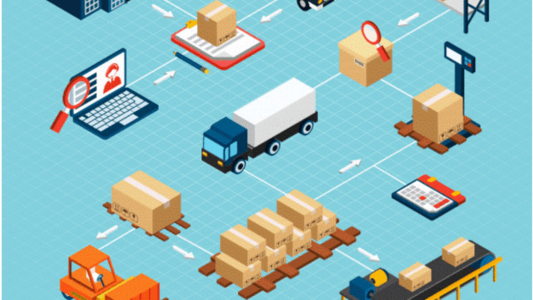The pharmaceutical industry is a highly specialized and demanding sector that faces unique challenges in its logistics and distribution operations. The task of bringing medications and treatments to patients safely, efficiently and quickly is essential to ensure their health and well-being.

Unlike other industries, such as food or fashion, the pharmaceutical industry entails certain special characteristics and requirements that make logistics and distribution management even more complex. When designing and operating logistics networks, the pharmaceutical sector faces the following challenges.
Challenges
Cold chain.
Many medications require temperature-controlled conditions to maintain their effectiveness and quality. The cold chain is a critical challenge in pharmaceutical distribution, as adequate storage and transportation conditions must be ensured from the manufacturing site to the point of delivery to the patient. The distribution network must guarantee the integrity of pharmaceutical products throughout the entire chain; it is essential to meet quality and safety standards.
Normative compliance.
This industry is subject to strict regulations regarding the distribution of medications. Complying with local and international regulations, ensuring product traceability and ensuring packaging safety are essential.
Geographic complexity.
Drug distribution involves reaching a wide variety of geographic locations, from large urban centers to remote rural areas. This geographic complexity presents logistical challenges, such as route optimization, transit time management, and selecting trusted logistics partners in each region. Guaranteeing coverage of this type of services is a priority and must be efficient and effective.
Inventory management.
Proper inventory management is essential to avoid shortages or excess of medicines in the distribution network. Challenges include accurately forecasting demand, optimizing inventory levels and implementing real-time tracking systems, ensuring complete visibility of products throughout the supply chain.
Likewise, there are special characteristics of many medications that make their inventory management difficult. In addition to storing many of them cold, their expiration date must always be taken into account. Immobilized inventories usually represent a significant investment in the cost of medicines, so batches of products must be avoided at all costs due to expiration in the supply chain.
Control of costs and delivery times.
The pharmaceutical industry constantly seeks to optimize costs and reduce delivery times in its distribution network. This involves seeking efficiencies in route selection, using advanced technologies for fleet tracking and management, consolidating shipments, and implementing just-in-time delivery strategies.
Reverse logistics.
Reverse logistics operations in the pharmaceutical sector involve the tasks of recovering and disposing of expired or unsold medications. This reverse flow of products constitutes a completely different logistics network, which also requires new facilities and collaborators.
Addressing these challenges requires innovative and technological approaches. Prescriptive analytics can play a critical role in providing modeling and optimization techniques to design efficient distribution networks, effectively manage inventories, and improve delivery times. These tools allow pharmaceutical companies to make data-driven decisions and maximize quality, efficiency and safety in their logistics operations.

Advanced Analytics Opportunities
1.- Design of the supply network.
Prescriptive analytics allows you to model the different components of the logistics system, analyze the variability of operations in different scenarios, such as final customer demand, growth expectations over the years or the effect of competition. From the analysis of this data or its simulations, decisions can be made such as the sizing of each link in the logistics chain, the resources necessary to guarantee a level of service, the potential bottlenecks of the entire process or the expected average KPIs.
2.-Reduction of delivery times.
Optimizing transport routes allows you to reduce the time required for medicines to reach distribution points. The design and operation of an efficient distribution network through advanced analytical tools favors, in turn, flexibility in the face of changes, being able to incorporate new origins or destination points to the routes and make decisions in the face of day-to-day variability, depending on fleet availability, delivery times, etc.
3.-Inventory optimization.
Predictive analytics can be used to predict future demand for drugs and treatments, allowing pharmaceutical companies to adjust their inventory levels accordingly. Furthermore, one of the most common applications of prescriptive analytics in the logistics sector is inventory policy management, ensuring that critical medications are always available in the right quantity at distribution points and reducing fixed assets.
4.- Control of expiration and quality of medicines.
Linked to the previous point of inventory management, the management of suppliers’ supplies and distribution from laboratories must be coordinated not only with the delivery times requested with the client, but also special features such as cold chain conservation or medication expiration monitoring must be taken into account at all times during the process. The correct planning of these operations allows us to reduce incidents in which the quality of the products may be affected.
All these opportunities can also be extended to the field of reverse logistics: from the prediction of returns in hospitals or the Point SIGRE, the classification and consolidation of inventories of different types of medicines, the planning of transport routes to the disposal and recycling plants and the sizing of these facilities.

As has been presented in some previous articles, advanced analytics has great potential to be applied in the logistics sector, modeling and resolving many of the strategic and operational decisions in this area quickly and efficiently.
In the pharmaceutical industry, these decisions encompass a special degree of complexity, with additional restrictions due to regulations and drug quality standards. However, it is because of this circumstance that advanced analytics tools constitute a good opportunity against manual planning and supervision of many of the aforementioned challenges.
Globalization, industry 4.0 innovations and high competition are key aspects that affect the pharmaceutical sector. Optimizing operations becomes essential, so the more profitable, faster and flexible your logistics operations are, the greater impact medicines will have on people’s health.
Are you interested in planning and optimizing your company’s production processes? ¡Click on the link and learn more about baobab solutions and the wide variety of solutions we offer!



